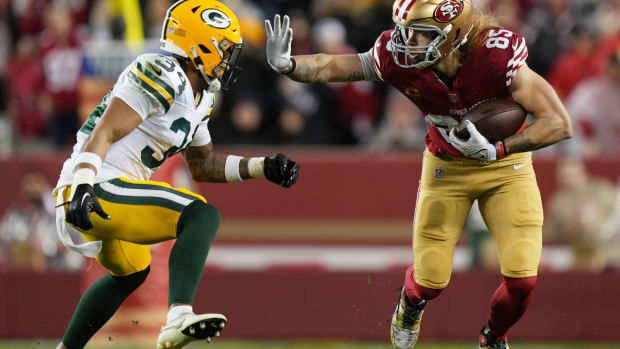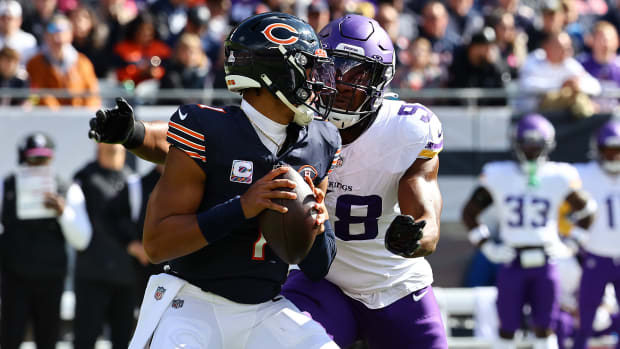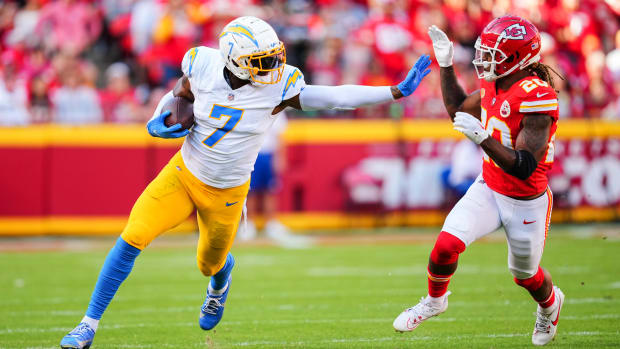Ryan Poles' Offseason Grade: C
The month of NFL training camps has arrived.
As such, it's high time to assess the grand total of what Chicago Bears GM Ryan Poles accomplished during the full offseason and assign a thumbs up, down or flat line to his efforts to improve the roster for coach Matt Eberflus.
The GM receives an overall grade of "C" from BearDigest for the efforts, a mark capped by the limited approach while they eyed 2023 as their best chance to bring in more expensive talent for the long haul.
They weren't getting a higher mark. They sacrificed for the future, for more cap space in 2023.
Here is how the C grade breaks down.
Off-Season Plan: B-
When the offseason began for the Bears, no one knew quite what Poles had in mind for a rebuild. Whatever it was, Poles would need to do it on the cheap because they had only a modest amount of cap space and many spots to address, combined with no first-round pick. It was here where the plan began.
The Bears would clear out as much cap space as possible for 2023 because their hands were largely tied by dead cap space for 2022. So, this year they would pursue low-cost free agents on short-term contracts. In many cases, these were even undrafted players. The Bears would look for cheaper, high-effort types who could help set a tone for new players coming into Halas Hall, emphasizing hard work and teamwork.
The idea for the plan is fine, necessary and creative. The problem was the execution.
They started with the biggest position need they had on defense for this scheme, the defensive tackle who plays three technique. They tried signing Larry Ogunjobi to a three-year, $40.5 million deal and when it was determined he failed the physical they scrapped the plan.
Since then the Steelers signed Ogunjobi.
The Bears also signed safety Dane Cruikshank, who has been injured all offseason. If they could sign Cruikshank, why couldn't they have simply signed Ogunjobi and kept him rehabbing until he was ready. In essence, they have done the same thing with the draft as seventh-round pick Elijah Hicks hasn't practiced, either. Only they know the answer why they decided this wasn't possible, and they aren't sharing medical information.
The entire situation could have been put in their past if they could have signed a different player with Ogunjobi's established reputation for disrupting offenses. Instead, their secondary option was Justin Jones. He has 4 1/2 career sacks and hasn't really played three technnique in a scheme like the Bears will run. He has lined up in this spot in the formation but it was with a 3-4 base front and assignments are different. Still, they're optimistic about his athletic ability.
The execution of this key aspect of the offseason plan failed right from the start. The rest of it worked fine, although they twice hit off-field obstacles when free agent receiver Byron Pringle and Matthew Adams were arrested.
The lack of a more high-profile receiver than Pringle in free agency also has drawn plenty of criticism.
Free Agency: C-
Additions: Justin Jones, DT; Lucas Patrick, C/G; Byron Pringle, LB; Nicholas Morrow, LB; Dakota Dozier, G; Al-Quadin Muhammad, DE; Matthew Adamms, LB; Dane Cruikshank, S; Equanimeous St. Brown, WR; Tajae Sharpe, WR; Dante Pettis, WR; David Moore, WR; Khari Blasingame, FB.
They kept the expenditures to $1.5 million or less on many acquistions while adding a few for a little more money and/or two-year contracts, like Patrick, Pringle, Muhammad and Morrow.
Patrick can play center or guard and Morrow supplies good speed but is limited in starting middle linebacker experience. He has started only two games at the Mike position. Patrick has started for two seasons, but only became a starter due to injuries. Muhammad and Adams are system replacements brought in from Eberflus' Colts teams. Pringle is a legitimate speed threat for possibly every receiver position but only last year did he play enough to gain any valuable experience
While the lack of one major free agent at receiver drew Poles criticism, it's been the right guard spot where real problems developed because Dozier was injured while battling former center starter Sam Mustipher. Dozier, a former Vikings backup, suffered a knee injury and went on IR, leaving only Mustipher and several rookies at the spot. Mustipher, himself, is a rookie to that particular position. If they had signed a different, starting-quality guard, they might not be in this situation.
Rather than address guard early in the draft, they then let it slide until Day 3. So, now they're left hoping there is someone who can contribute as starter.
One other alternative is scraping up someone who gets cut by another team during training camp or at the end of it. A last option is converting another player to guard, like Borom, Kramer or Jenkins
Key Lost Players: Khalil Mack, OLB; Allen Robinson II, WR; Akiem Hicks, DE; James Daniels, G; Jason Peters, T; Eddie Goldman, NT (released); Bilal Nichols, DE (FA); Tarik Cohen, RB; Danny Trevathan, ILB (released), Alec Ogletree, ILB; Tashaun Gipson, S (FA); Nick Foles, QB (released); Andy Dalton, QB (FA)
The trade of Khalil Mack was the key move as it gave them draft day help to select saftey Jaquan Brisker. Goldman, Cohen, Trevathan and Foles all were released for cap purposes but none figured into plans for 2022. Goldman was a 3-4 nose and Trevathan a 3-4 linebacker and didn't fit the new system. Foles was being paid too much to be a third-string QB. Hicks was aging and another square peg for the round holes needed in their new defense. Nichols and Daniels were free agents and Daniels' commanded a big $26.5 million deal the Bears probably couldn't afford to match, unless they scrapped plans for some of the other positional moves. But looking back at it now it might have been preferable to have Daniels and they wouldn't face the problem they now have at right guard.
Robinson's departure had long ago been decided upon by the old regime and Poles didn't see a need to keep him, either. Robinson was an expensive non-factor last year. They brought in players who will attempt to replace him, and it shouldn't be hard being better than the 38 catches he had last year. The Robinson who the Bears had two years ago wasn't the same player as this one they had last year.
Draft: C+
Second Round: Kyler Gordon, CB; Jaquan Brisker, S.
Third Round: Velus Jones Jr., WR.
Fifth Round: Braxton Jones, OT; Dominique Robinson, DE.
Sixth Round: Zachary Thomas, G/T; Trestan Ebner, RB; Doug Kramer, C.
Seventh Round: Ja'Tyre Carter, G/T; Elijah Hicks, S/CB; Trenton Gill, P.
The goal was get best available talent early, then to get as many picks as possible by trading down with hopes they might pull in someone who could be a real late-round find.
Poles received crticism for drafting two defensive players first, but the Bears had both players well up on their draft boards ahead of any potential receiver picks. Many—if not all— the receivers they could have taken ahead of Velus Jones Jr. instead of drafting Brisker and Gordon in Round 2 had legitimate question marks: Georgia's George Pickens, Western Michigan's Skyy Moore and Cincinnati's Alec Pierce. Jones physically has the ability to do what all of those other players could do and is said to be more mature at age 25. However, it took him six years and two colleges to show this.
The Bears aimed their draft strategy at obtaining as many players as possible once they had their top three, and it's possible they obtained a few gems down below. Robinson and Braxton Jones received extensive looks in offseason work and could impress.
The greatest draft problem they were left with was a huge gap from early Round 3 to when they picked in Round 5, and there was potential help at the guard position removed from the board during this point. The other problem is that while they managed to get 11 draft picks after starting with six, all but three are in the final three rounds.
Poles will have a first-round pick next year and the draft could look much more balanced.
Twitter: BearDigest@BearsOnMaven




